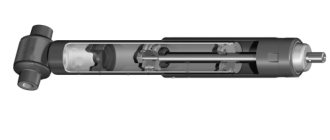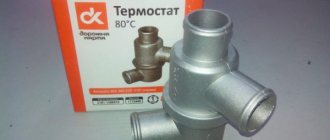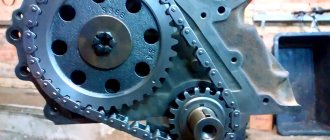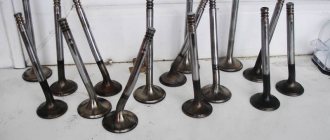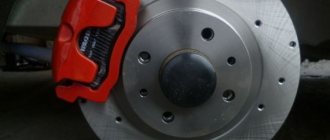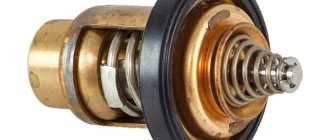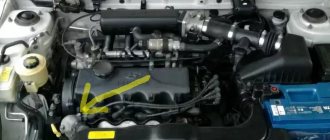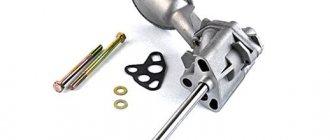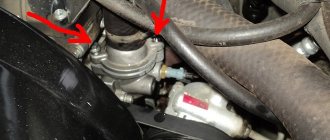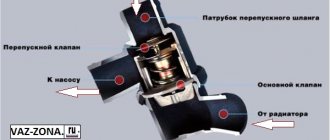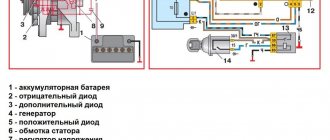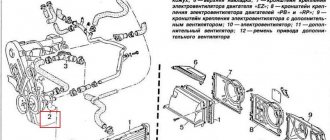The temperature of the internal combustion engine is a parameter that must be monitored especially carefully. Any temperature deviation from the values set by the engine manufacturer will lead to problems. At best, the car simply won't start. In the worst case, the car’s engine will overheat and jam so much that it will not be possible to do without expensive major repairs. This rule applies to all domestic passenger cars, and the VAZ 2107 is no exception. The thermostat is responsible for maintaining the optimal temperature regime on the “seven”. But it, like any other device in a passenger car, can fail. Is it possible for a car owner to replace it himself? Of course. Let's take a closer look at how this is done.
Thermostat Specifications
The cylindrical thermostat is equipped with three outlets for pipes - from the engine, from the radiator and to the circulation pump. You can get acquainted with the design in more detail by looking at the cross-section of the thermostat:
Thermostat VAZ 2107 cross-section
When the engine starts, coolant flows through the cylinder block and pump, once above 80 degrees is reached, the main valve shutter begins to allow antifreeze through the radiator. As the liquid temperature rises, the throughput of the valve increases, while at the same time the bypass valve closes the flow of antifreeze from the engine. The mark of 94 degrees is considered the maximum at which the liquid moves exclusively in a large circle (the main valve is open, the bypass valve is pressed tightly).
This is interesting: Windshield wiper motor - when is repair inevitable?
What will you need for replacement?
Before starting work, you need to make sure you have:
- New working part.
- Wrenches or socket heads with a ratchet and an extension “10” and “13”.
- Phillips and slotted screwdrivers (depending on the bolt heads of the worm clamps used).
- Containers with a volume of about 10 liters for coolant, preferably low and wide; a basin is perfect for this role. If you plan to reuse antifreeze, the container must be clean.
In most cases, up to three new clamps and at least 1–2 liters of antifreeze, similar to that poured into the car, will also be useful, because it is difficult to completely eliminate coolant loss when draining it. The following will help increase the convenience and efficiency of repairs:
- Socket wrench “7” or “8”, suitable for loosening and tightening clamps.
- Pliers that make it easier to remove the factory-installed band clamps on the Classic.
- A funnel for collecting coolant, for example, cut from a plastic bottle.
Often, replacing the thermostat on a Zhiguli is combined with pouring fresh antifreeze and installing new pipes or other parts of the cooling system. In this case, it is necessary to purchase the appropriate spare parts and coolant (total filling volume is 8.65 liters, that is, a little more than 9.5 kg).
Description, device and principle of operation.
The thermostat, also known as the “seven” thermostat, is a part that is a cylindrical container with three outlets for pipes. At the upper end of the part there is an inlet pipe from the engine, at the bottom there is an inlet pipe coming from the radiator, and the third outlet pipe is located on the top side. The thermostat device can be seen in more detail in the photo below.
If the engine is started “cold”, antifreeze passes through the cylinder block and the pump, the so-called small circle. This ensures quick warm-up of the engine. When the temperature reaches 80.6 to 81.5 degrees Celsius, the main thermostat valve begins to open, and the antifreeze begins to move in a large circle through the radiator. At the same time, the bypass valve gradually shuts off the antifreeze coming from the engine. When the temperature reaches 94 degrees, the valve opens to its maximum value, the coolant moves only in a large circle.
What signs of malfunction occur?
This device can get stuck in both the open and closed states, as well as in one of the middle states. Therefore, cooling malfunction can be of two types,
- The engine will overheat and the antifreeze will boil if the valve is closed and the liquid does not enter the radiator. Then, at least for some time, turning on the stove at full heat and maximum airflow can help. Naturally, this option is the most dangerous.
- The engine will take much longer to warm up if the valve is “stuck” open. This is still better than the first option, but the thermostat still needs to be replaced.
Malfunctions and testing of the VAZ-2107 thermostat
Malfunctions:
- does not open at all or opens partially - leads to engine overheating;
- does not close - the engine heats up slowly after a cold start, the engine does not reach operating temperature.
To find out the functionality of the thermostat, you should check at what temperature its main valve begins to open, as well as the stroke of this unit. Since the thermostat itself is mounted in a non-separable housing, this can only be done accurately using special equipment (for example, the BS-106.000 stand).
The simplest check of the VAZ-2107 thermostat can be performed directly on the car by touch.
In the case of a working thermostat, after starting a cold engine, the lower radiator tank should not heat up immediately, but when the arrow on the coolant temperature gauge is 3–4 mm from the red scale zone, which corresponds to 80–85 °C.
If the radiator starts to heat up immediately, this means that the thermostat is not closing. If it’s later, its valve gets stuck. An overheating engine can be evidence of insufficient valve travel when it does not open completely. In all cases, the thermostat must be replaced.
First, the antifreeze is drained from the cooled engine. Using a slotted screwdriver with a thin blade or pliers, loosen the clamp securing the hose supplying antifreeze from the radiator to the thermostat pipe. Disconnect this hose.
Use a Phillips screwdriver or an 8 mm socket wrench to loosen the clamps securing the hoses to the pipes of the cylinder block and pump. Remove the thermostat along with the hoses.
Disconnect the hoses from the thermostat pipes and put them on the new thermostat. Instead of the tape clamps that were on the hoses, they put on worm-drive clamps without tightening them.
The lower pipe of the thermostat is connected to the hose from the radiator. Connect the remaining hoses. All clamps are tightened. Fill in coolant. Start the engine and check for antifreeze leaks and the operation of the new thermostat.
Didn't find the information you are looking for? on our
forum
.
If you find an error, please highlight a piece of text and press Ctrl Enter.
The VAZ 2107 thermostat (injector) is a simple device, so it has only 3 possible faults:
- It does not open, constantly passing antifreeze through the small circuit. The engine does not cool down.
- It opens only partially, which reduces engine cooling efficiency.
- It does not close, constantly passing antifreeze through a large circuit (through the radiator). In this case, the engine does not warm up to the optimal operating temperature.
To check the functionality of the thermostat, you should check at what temperature of the antifreeze the valve begins to open. It is also necessary to check the maximum valve stroke. Given the non-separable and opaque body, it is impossible to fully test the thermostat without a special stand. But it is quite possible to carry out a simple test of functionality simply by touch.
If the thermostat is working properly, the tank at the bottom of the radiator does not warm up immediately after starting the engine, but after the temperature gauge shows 80–85 degrees (the instrument needle stops 4 mm from the red zone of the instrument scale).
If the lower tank starts to heat up immediately, this indicates that the thermostat is not closing. If even after warming up the antifreeze the lower reservoir remains cold, the thermostat jams (does not open).
Insufficient valve hot-pot can be determined by the fact that the engine is overheating (the latter, however, may have other reasons).
If there is any malfunction of the thermostat, it must be replaced.
This device can get stuck in both the open and closed states, as well as in one of the middle states. Therefore, cooling malfunction can be of two types,
- The engine will overheat and the antifreeze will boil if the valve is closed and the liquid does not enter the radiator. Then, at least for some time, turning on the stove at full heat and maximum airflow can help. Naturally, this option is the most dangerous.
- The engine will take much longer to warm up if the valve is “stuck” open. This is still better than the first option, but the thermostat still needs to be replaced.
You can check the functionality of this simple device very simply. As soon as the arrow of the coolant temperature indicator becomes vertical, which indicates that the engine has warmed up to operating temperature, you need to do the following: touch hose 5 or the radiator pipe. It should gradually heat up as antifreeze begins to flow through it. Pipe 14 should be colder, since the liquid coming from the radiator has already cooled.
If it continues to remain cold despite the temperature rising, then the valve is stuck in the closed position. If it has the same temperature as the others and the cylinder block, then the valve is open from the very beginning, and the thermostat also needs to be replaced.
- Engine overheating - the thermostat opens partially or does not open completely.
- When first started, the engine heats up slowly and does not reach operating temperature - the thermostat does not close.
Changing the thermostat on a classic - explanation of the replacement steps
- We drain the antifreeze, we discussed how to do it correctly in the article on how to change the coolant in a VAZ. In our case, you can close the cabin heater tap so as not to drain the liquid from the stove.
- We remove the terminals from the battery and pull it out of the car.
This should be done to facilitate access to the thermostat when replacing it.
Additionally, removing the washer reservoir will help free up space for work on models with an injection engine. To do this, pull off the terminals of the motor wires, remembering their location, move the tank up the bracket and place it in the air intake box. The flexible tube going to the windshield nozzles is long enough, so you can do without disconnecting it and draining the washer fluid.
Advertising:
- Unscrew the clamps and remove them.
It is advisable to replace them with new ones. Because, over time, they stretch, and when the hose is pressed again, they can leak or unscrew on their own. Ideally, you should use spring clamps, used on modern cars, instead of tape or worm clamps. When installing such connecting elements, it is extremely important to choose the correct diameter.
- We remove the thermostat and replace it with a new one.
It is best to first release the part from the shortest pipe leading to the cylinder block by pulling the assembly towards you. After this, removing the upper hose attached to the cylinder head and the side hose (to the radiator) will not be difficult.
Advertising:
At the same time, we carry out diagnostics of the hoses for elasticity and absence of ruptures and cracks. Otherwise, we change them. It is advisable to inspect the pipes before carrying out work, so that, if necessary, you can purchase a new spare part in advance.
Advertisement
- Before installing a new thermostat, it must be inspected.
We carry out a visual inspection. If there are burrs or casting defects on the nozzles, where the hose is attached, they should be treated with sandpaper or a file. We check that the insides of the thermostat are intact and that the valves are not stuck in the open position.
It is recommended that before replacing the thermostat, you test it in hot water to ensure that it is working properly. To do this, fill a basin with hot water at a temperature of 90 degrees and lower the thermostat into it. If you can visually see that the valves open and close, then it is working properly and you can install it on the car.
Video on how to check the functionality of a new thermostat before replacing it:
- We install the new thermostat in place.
We put the hoses on the pipes and tighten them with clamps.
It is recommended to wrap several layers of electrical tape under the clamps. This is necessary so that the hose is not damaged by the clamp. Often antifreeze begins to leak from this place, the clamp tape “cuts” it.
Pour coolant into the system. We displace the air and check for leaks in the places where the thermostat is attached with hoses. If necessary, tighten the clamps. I described in detail how to properly fill in new antifreeze and not air out the system in previous articles, the link is provided at the beginning of the review .
This is interesting: Car shock absorbers - protection from rough roads
All about the thermostat VAZ-2107
This article is for those who want to thoroughly understand how the thermostat of the VAZ “classic” works and works, how to determine the malfunctions of this device, select the right spare part and perform a replacement. It is the thermostat that is to blame for the fact that in winter the cabin is cold and the engine takes a long time to warm up. It is also the most common cause of engine overheating.
What's inside the thermostat
The classic thermostat housing was originally made of brass. Then, different factories at different times produced thermostats with housings made of aluminum alloy and steel. During assembly, a block of two assembled valves is placed inside the two halves of the housing. Then it all gets rolled up and becomes inseparable. The valve block is assembled inside the holder. The rod is fixed motionless. The main and bypass valves can move relative to it, overcoming the force of the springs. On the outside, the housing has three pipes for connection to the water pump (pump), engine and radiator.
1. Inlet pipe (from the engine). 2. Bypass valve. 3. Bypass valve spring. 4. Glass. 5. Rubber insert. 6. Outlet pipe. 7. Main valve spring. 8. Main valve seat. 9. Main valve. 10. Holder. 11. Adjusting nut. 12. Piston. 13. Inlet pipe from the radiator. 14. Filler. 15. Clip. D - fluid inlet from the engine. R - fluid inlet from the radiator. H - liquid outlet to the pump (pump).
How does the VAZ-2101-2107 thermostat work?
After starting a cold engine, antifreeze begins to be pumped through the thermostat housing from the engine to the pump, through the upper and middle pipes. The main valve is closed and does not allow fluid into the radiator, and the bypass valve is open. The engine warms up and the coolant temperature rises. Gradually, heat is transferred to a special filler, which, pushing away from a stationary piston, lifts the valves up (as shown in the picture). The filler and piston must be adjusted so that the opening of the main valve begins at a temperature of 81 degrees C with a tolerance of +4 - +5 degrees (note - only a plus!). The liquid begins to circulate through the radiator and cool, but some of it still passes directly to the pump. Next, the valve rises 6 mm and, at the end of the stroke, closes the bypass valve. If it is not closed, the antifreeze will spin in a “small circle” - pump-motor-thermostat-pump, and this will lead to overheating. The liquid pumped through the radiator quickly cools itself and cools the filler in the thermostat. It compresses, the valves move down with a spring, opening the bypass valve and closing the main valve. This process is continuously repeated, maintaining the engine temperature between 87 and 92 degrees. This is how the thermostat of a car that has recently rolled off the production line works. You don’t need any cardboard, but you will only have to insulate the “face” in frosts below 40!
Malfunctions of the VAZ-2107 thermostat, checking operation
Nothing is eternal under the Moon! And the thermostat gets tired over time. The properties of the filler change, the rubber of the valves becomes dull, and the springs lose their elasticity. We notice that the VAZ-2107 takes a long time to warm up, and in cold weather the temperature gauge needle barely reaches the edge of the green sector. This malfunction can progress and, over time, the temperature will end up in the middle of the white sector of the scale. You can check the operation of the thermostat without removing it from the engine. This is done like this: start the cold engine and feel the lower pipe near the thermostat with your hand. It should not become warm until the temperature indicator needle reaches a point 3-4 mm from the red zone of the scale. If the heat is felt earlier, the thermostat is not fully operational. The second malfunction is engine overheating due to a stuck thermostat. Here everything looks like this - the engine is hot, but the radiator and its pipes are cold. A thermostat with a stuck valve needs to be replaced urgently. If a malfunction occurs far from civilization, you can pick out the main valve and drive to the repair site. There is no need to remove both valves; the engine will overheat, because the “small circle” is not closed.
We select a replacement for a faulty VAZ-2107 thermostat
Is it worth changing it? If the thermostat is stuck, then it is not discussed, of course, changing it. But if it’s underheating, then it’s worth thinking about. The fact is that today it is very difficult to buy a normal thermostat that meets all the parameters. They all work, they open, but too early, or the spring is weak. And, having installed such a product, we get a coolant temperature of 75-80 degrees. This corresponds to the end of the white sector of the temperature indicator. So, if your thermostat does not heat up within such limits, then you should not change it. The exception is when you know for sure that you bought a quality spare part. When purchasing a thermostat, quality can only be assessed approximately. To do this, we inspect the case, packaging, and markings. The assembly must be neat, the coloring must be even and of high quality. Markings must be present - who the manufacturer is, brand and temperature. “Classic” thermostats are designed for a temperature of 82 degrees - this is the beginning of the valve opening. I came across markings of 80 degrees, 83 degrees. There are rumors that there are 90-degree devices on sale, but I have never seen such devices.
Thermostat with steel housing, painted
Thermostat with aluminum alloy body
After an external inspection, try blowing air into the lower pipe. If air passes through, the valve is leaking, take another copy. At home, before you start replacing, give the purchased device one more check. Place it in a suitable pan, fill it with water and place it on the stove. When the water almost boils, carefully, so as not to get burned, remove the thermostat and try to pour water from the tap into the middle pipe. It should flow freely into the lower pipe. The flowing water will cool the filler, and the valve will close again, and water will flow from the upper pipe. If everything is so, then your thermostat is working properly and can be installed on the car.
Replacing the thermostat
In addition to the thermostat itself, we may need new pipes, clamps, and antifreeze. The total capacity of the VAZ-2107 cooling system is 9.85 liters. It is better to use worm clamps; choose thicker ones. It is better to replace the pipes, since the old ones are already hardened and may leak during installation. The procedure is as follows: 1. Disconnect the terminals and remove the battery. 2. Drain the antifreeze through the radiator and block drain plugs; you can simply remove the lower radiator pipe. Place a basin under the car. 3. Loosen the clamps on the engine, pump and radiator. 4. Remove the thermostat along with the pipes. 5. We install new pipes on the new thermostat and tighten them with clamps. 6. Place the assembled unit in place and tighten the clamps. 7. Close all open plugs and fill in fresh antifreeze. 8. Start and warm up the engine until the thermostat opens, add antifreeze. If there is any air left, we raise the front of the car on a suitable hill and run the engine with the radiator cap open for several minutes at 2000 - 3000 rpm. Usually this is enough. 9. Add antifreeze to the radiator and expansion tank, close the plugs tightly. There are a lot of questions about sealant - do I need to coat the places where the pipes fit? If the pipes are soft and the clamps are good, then sealant is not needed.
How to Change the Thermostat on a VAZ Video
As a delivery
thermostat VAZ 2107 The VAZ 2107 thermostat is a device that maintains the temperature of the antifreeze within these limits. Operating a vehicle with a faulty thermostat will lead to increased fuel consumption, reduced service life and, in addition, engine failure. Therefore, the thermostat must be replaced immediately at the slightest sign of malfunction.
Purpose of the thermostat VAZ 2107 injector
The thermostat is installed at the intersection of the large and small engine cooling circles. This is a temperature-sensitive valve that switches the flow of antifreeze in a small circuit (through the cylinder block), in other words, in a large one (through the radiator, depending on its temperature. The thermostat regulates the nozzles from the pump, engine and radiator. When this problem is solved, the position of the antifreeze from the water pump is directed to the cylinder block, bypassing the radiator, and the fluid in the radiator does not participate in cooling. The freeze of 80-90 degrees the temperature-sensitive element increases, moving the valve cover cover, while a fraction of the antifreeze circulates more paths passing through the radiator. When the engine cools, reverse process, antifreeze circulates through a small circuit
.
Depending on the engine operating mode, temperature and air speed (intensity of air flow to the engine and radiator), the antifreeze temperature fluctuates, and the thermostat opening value changes accordingly. The best operating temperature of the engine is maintained for a given ratio.
VAZ 2107 thermostats differ in design, regardless of engine type, and are a solid cylindrical body with a thermal valve inside. The housing is equipped with 3 nozzles for connecting radiator hoses.
VAZ 2107 is boiling! REASONS AND REPLACEMENT OF THERMOSTAT!
In this video
let's talk about the main reasons for overheating of the VAZ 2107
and at the same time change
the thermostat
!
Thermostat malfunctions and their identification
The VAZ 2107 thermostat (injector) is a simple device, so it has only 3 possible problems:
- The small circuit
that is constantly transmitted by antifreeze is not disclosed . The engine is not cooling. - It is only partially opened, which reduces the cooling efficiency of the engine.
- It does not close, constantly passing antifreeze through a large circuit (through the radiator). And then the engine does not warm up to a good operating temperature.
To check the operation of the thermostat, you should check at what temperature the antifreeze valve begins to open. Also check the maximum valve stroke. Given the continuous and opaque body, it is impossible to fully test the thermostat without a special screen. But you can run a simple health test just by touch.
If the thermostat is working, the tank in the lower part of the radiator does not heat up immediately after starting the engine, but if the thermometer shows 80-85 degrees (the instrument needle will stop 4 mm from the reddish scale of the instrument).
If the lower tank starts to heat up immediately, the thermostat will not close. If the lower tank remains cold even after the antifreeze has warmed up, the thermostat is stuck (do not open).
The absence of hot valves is determined by the fact that the engine is overheating (the latter, however, has other rooms).
If the thermostat is faulty, it must be replaced.
Replacing the thermostat VAZ 2107
The work of replacing a thermostat does not require the highest qualifications and expensive tools (lamps). Loosening and tightening the clamps that hold the coolant hoses requires only slotted screwdrivers and a Phillips or 8-screw wrench. The procedure looks like this:
- Wait until the engine cools down.
- Drain the antifreeze.
- Unscrew the clamp on the radiator pipe to the thermostat. Disconnect the hose.
- Release the clamps and disconnect the hoses from the cylinder block and pump nozzle to the radiator and disconnect the hoses.
- Remove the thermostat
along with the 3 hoses attached to it. - Remove the thermostat hose clamps and remove them.
- If the belt clips are installed on the thermostat, give
them a worm. - Connect the hoses to the new thermostat and put the clamps on without placing them in the long box.
- Install the new thermostat on the car, attach the hoses and clamps to the corresponding pipes.
- Tighten the clamps
- Add coolant.
- Start the engine, make sure there is no antifreeze or the new thermostat is working.
How to change the thermostat on a VAZ 2107 video.
Source
Post Views: 2
How to check the thermostat without dismantling it?
If the unit is working properly, then after starting a “cold engine”, the lower pipe leading to the radiator should not heat up immediately, but only when the engine temperature reaches 80-88 degrees. Also, if this pipe does not heat up at all, and the engine does not overheat, this indicates a malfunction of the unit. Accordingly, if at minimum temperatures the lower pipe begins to heat up, this also indicates a malfunction.
To replace you will need:
- new thermostat
- crosshead screwdriver
- clamps (if necessary)
- pipes (if necessary)
- coolant
- sealant (if necessary)
- The first step is to drain the coolant (only on a cold engine).
- we drive the car into the pit (the car must be strictly horizontal!),
- move the warm air supply lever to the right,
- unscrew and remove the expansion tank cap,
- unscrew the radiator filler cap,
- unscrew the drain plug on the cylinder block (place a container under the drain in advance!),
- unscrew the radiator drain plug (place a container under the drain in advance!),
- The remaining coolant can be drained by unfastening the belt securing the expansion tank and lifting it up.
- For convenience, you can remove the battery.
- Unscrew the old clamps and remove the thermostat.
- Next, install a new thermostat (if necessary, you can replace the pipes and clamps).
- Fill with coolant, test the new part (described above).
Malfunctions:
- On a cold engine, open the neck of the radiator and expansion tank, unscrew the plug on the cylinder block, and drain all the antifreeze.
- We unscrew the clamps, remove the device and replace it with a new one;
- Taking this opportunity, we wash the cooling system with a special wash, preferably a branded one, with orthophosphoric acid and fill it with fresh antifreeze.
After this, you need to check the operation of the thermostat. Thus, replacing the device is an easy operation that can save a lot of money if you take into account the possibility of the engine jamming.
Ways to solve problems
Possible solutions to the problem include:
1. If the coolant temperature exceeds the norm (provided the thermostat is working and it is correctly selected), it is necessary to replace the device, but with a higher opening temperature. As a rule, this step is recommended for motorists who operate cars in the mountains and in regions with hot climates.
2. When opening the thermostat late, it is important to ensure that there are no plugs and that the system is completely filled. If the problem is caused by a plug (coolant stagnation), then the best solution is to make a small hole in the plate (2-3 mm). As a result, the coolant flow around the thermostat is normalized, and the engine warm-up time increases.
3. Early opening of the thermostat is possible due to excessive pressure in the system. Zones of different pressure often appear around the device, which leads to its early operation. There are several reasons:
- failure of the cooling system;
- The thermostat spring has weakened;
- The engine runs at higher speeds during the warm-up period.
4. The engine takes too long to warm up.
Causes:
- incomplete closing of the thermostat;
- violation of the integrity of the valve plate (for example, a gap has appeared);
- Incorrect position (possibly changing the location of the air valve).
5. The engine heats up above normal even in a situation where the thermostat is fully open:
- traffic jams or low coolant level;
- failure of the radiator (clogging of its cells);
- failure of the cooling pump or fan;
- contamination of the cooling system.
Signs of a broken thermostat
Since the main main part of the thermostat is the bypass valve, the vast majority of breakdowns are associated with this part. We list the most common symptoms that should make the driver wary:
- The engine overheat indicator light came on on the dashboard. This situation occurs when the central thermostat valve is stuck and is unable to open. As a result, antifreeze cannot go into the radiator and cool down there; it continues to circulate in the engine jacket and eventually boils;
- After a long period of inactivity, the car is very difficult to start (especially in the cold season). The cause of this problem may be that the central thermostat valve is only opening halfway. As a result, part of the antifreeze goes not into the engine jacket, but into the cold radiator. Starting and warming up the engine in such a situation is extremely difficult, since warming up the antifreeze to the standard temperature of 90°C can take a long time;
- damage to the main bypass valve. As you know, the valve in the thermostat is an element sensitive to temperature changes. Inside the valve there is a special industrial wax that expands greatly when heated. The wax container may lose its seal and its contents will spill into the thermostat. This usually happens as a result of strong vibration (for example, if the “seven” engine constantly “trips”). After the wax leaks out, the thermostat valve stops responding to the temperature, and the engine either overheats or starts poorly (it all depends on exactly what position the leaking valve is stuck in);
- The thermostat opens too early. The situation is still the same: the tightness of the central valve was broken, but the wax did not completely flow out of it, and the coolant took the place of the leaked wax. As a result, there is too much filler in the valve container and the valve opens at lower temperatures;
- damage to the sealing ring. There is a rubber ring on the thermostat that ensures the seal of this device. In some situations the ring may break. Most often this happens if oil gets into the antifreeze due to some kind of breakdown. It begins to circulate in the engine cooling system, reaches the thermostat and gradually corrodes the rubber o-ring. As a result, antifreeze enters the thermostat housing and is constantly present there, regardless of the position of the central valve. The consequence of this is engine overheating.
About choosing a thermostat for VAZ 2107
When the standard thermostat on the “seven” fails, the car owner inevitably faces the problem of choosing a replacement thermostat. There are many companies on the market today, both domestic and Western, whose products can also be used in the VAZ 2107. Let’s list the most popular manufacturers.
Gates thermostats
Gates products have been represented on the domestic auto parts market for a long time. The main difference between this manufacturer is the wide range of thermostats produced.
Here are classic thermostats with valves based on industrial wax, and thermostats with electronic control systems created for more modern machines. Relatively recently, the company began producing case thermostats, that is, devices supplied complete with a proprietary case and pipe system. The manufacturer claims that the efficiency of a motor equipped with their thermostat will be maximum. Judging by the consistently high demand for Gates thermostats, the manufacturer is telling the truth. But you have to pay for high reliability and good quality. The price of Gates products starts from 700 rubles.
Luzar thermostats
It will probably be difficult to find a “Seven” owner who has not at least once heard about Luzar thermostats. This is the second most popular manufacturer in the domestic auto parts market. The main difference between Luzar products has always been the optimal price-quality ratio.
Another characteristic difference is the versatility of the produced thermostats: a device suitable for the “seven” can be installed on the “six”, “kopek” and even “Niva” without any problems. Finally, you can purchase such a thermostat in almost any auto store (unlike Gates thermostats, which cannot be found everywhere). All these points made “Luzarovsky” thermostats incredibly popular among domestic car enthusiasts. The cost of the Luzar thermostat starts from 460 rubles.
Finord thermostats
Finord is a Finnish company specializing in automotive cooling systems. It produces not only various radiators, but also thermostats, which are highly reliable and very affordable. The company does not provide any specific information about the production process of its thermostats, citing trade secrets.
All that can be found on the official website is assurance of the highest reliability and durability of Finord thermostats. Judging by the fact that the demand for these thermostats has remained consistently high for at least ten years, the Finns are telling the truth. The cost of Finord thermostats starts from 550 rubles.
Wahler thermostats
Wahler is a German manufacturer specializing in thermostats for cars and trucks. Like Gates, Wahler provides car owners with a wide range of models, from electronic thermostats to classic ones with industrial wax. All Wahler thermostats are thoroughly tested and are characterized by the highest reliability. These devices have only one problem: their price is very high. The simplest Wahler single-valve thermostat will cost the car owner 1,200 rubles.
Here we should also mention the counterfeits of this brand. Now they are becoming more and more common. Fortunately, the fakes are made very clumsily, and are given away primarily by the poor quality of packaging, printing and the suspiciously low price of 500–600 rubles per device. A driver who sees a “German” thermostat sold at such a more than modest price should remember: good things have always been expensive.
So which thermostat should a car enthusiast choose for his “Seven”?
The answer is simple: the choice depends only on the thickness of the car owner’s wallet. A person who is not short of money and wants to replace the thermostat and forget about this device for many years can opt for Wahler products. If you don’t have a lot of money, but you want to install a high-quality device and at the same time have time to look for it, you can choose Gates or Finord. And finally, if money is really tight, you can simply install a Luzar thermostat from the nearest auto store. As they say - cheap and cheerful.
Adviсe.
- When you drain the coolant, it is better not to open the expansion tank cap right away. In this case, the liquid will flow slowly due to the vacuum created.
- When you unscrew the plug on the block, slowly unscrew the tank cap.
- In order not to get rid of air in the pipe after filling the liquid, you can remove the thin hose supplying coolant to the carburetor, located in the rear part. Fill in the coolant, watch when it flows out of the hose. This will indicate that the air has escaped; this is the highest point of the coolant in the car.
Methods for checking the health of the thermostat
If the driver detects one of the above malfunctions, he will have to check the serviceability of the thermostat. At the same time, there are two ways to check this device: with removal from the car and without removal. Let's talk about each method in more detail.
Checking the device without removing it from the car
This is the simplest option that every car enthusiast can handle. The main thing is that the engine is completely cold before starting the test.
- The engine starts and idles for 20 minutes. During this time, the antifreeze will heat up properly, but it will not yet enter the radiator.
- After 20 minutes, carefully touch the upper thermostat tube with your hand. If it is cold, it means that the antifreeze circulates in a small circle (that is, it enters only the cooling jacket of the engine and the small stove radiator). That is, the thermostat valve is still closed, and in the first 20 minutes of operation of a cold engine this is normal.
By touching the upper pipe with your hand, you can check the serviceability of the thermostat
- If the upper tube is so hot that it is impossible to touch it, then the valve is most likely jammed. Or it has lost its tightness and stopped responding adequately to temperature changes.
- If the upper thermostat tube heats up, but it does so very slowly, this indicates that the central valve is not fully opening. Most likely, it is stuck in the half-open position, which in the future will lead to difficult starting and a very long warm-up of the engine.
Checking the device by removing it from the car
Sometimes it is not possible to check the serviceability of the thermostat using the above method. Then there is only one way out: remove the device and check it separately.
- First you need to wait until the car engine has completely cooled down. After this, all the antifreeze is drained from the car (it is best to drain it into a small basin, having first completely unscrewed the cap from the expansion tank).
- The thermostat is supported by three pipes, which are attached to it using steel clamps. These clamps are loosened with a regular flat-head screwdriver and the pipes are removed manually. After this, the thermostat is removed from the engine compartment of the “Seven”.
The thermostat without clamps is removed from the engine compartment
- The thermostat removed from the car is placed in a pan of water. A thermometer is also placed there. The pan is placed on the gas stove. The water gradually warms up.
A small pan of water and a household thermometer are suitable for checking the thermostat.
- All this time you need to monitor the thermometer readings. When the water temperature reaches 90°C, the thermostat valve should open with a characteristic click. If this does not happen, the device is faulty and needs to be replaced (thermostats cannot be repaired).
Video: checking the thermostat on a VAZ 2107
Checking the Thermostat
The problems described above can appear at any time. To avoid engine overheating and damage, you need to know how to check the thermostat directly on the car and after dismantling it at home.
It is important to know that after starting the engine, the thermostat is still closed and the coolant flows through a small circuit (through the cooling jacket and the stove). This allows the power unit to quickly reach the desired temperature.
As soon as the required level is reached, the valve opens and coolant flows through the main radiator.
Understanding this principle is very important when checking the thermostat.
Therefore, we invite you to familiarize yourself with the diagram.
Let's consider two diagnostic options.
Without dismantling
The easiest way is not to remove the unit, but to check it directly on the car. The main condition is a cold engine.
The diagnostic process begins with starting the power unit and warming it up for 2-3 minutes at idle.
This time is not enough for the engine to warm up and the coolant to circulate in a large circle, so the radiator is not yet connected to the general cooling system.
To check that the system is working correctly, touch the pipe that goes to the top of the main radiator with your hand.
The pipe should be cold, which signals the passage of coolant in a small circle (only through the engine and stove).
Therefore, the valve of the device under test is in the closed position (as it should be at this stage).
Continue to monitor engine cooling system performance. As soon as the coolant warms up to 90 degrees Celsius (can be controlled by the sensor), touch the inlet pipe. The thermostat should be open at this moment.
In this case, the coolant is directed in a maximum circle (encompassing the radiator). In such a situation, the pipe that extends from the radiator will be well heated.
By the way, the lower pipe of the cooling system, extending from the radiator, will also be hot.
If the condition described above is not met, then we can talk about a breakdown of the thermostat and its incorrect operation (for example, the valve could be jammed). In such a situation, you need to check it and replace it if necessary.
The second option is also possible, when after starting the engine the tube leading to the radiator warms up almost immediately.
One of the reasons is the valve jamming in the open position and, as a result, the coolant moving in a large circle at once.
The result in this case is obvious - the power unit will not operate in normal mode due to the impossibility of reaching normal temperature conditions.
Such a malfunction is not dangerous for the engine, but can lead to increased fuel consumption.
Situations are possible when the valve “hangs” in the middle position, that is, it does not close or open fully. The problem is diagnosed by the long warm-up of the power unit.
It is more difficult to determine a malfunction in “field” conditions.
In this case, checking the thermostat can only be done by dismantling it.
Checking the functionality of the thermostat by removing
If it is not possible to determine the breakdown without dismantling, then proceed as follows:
- pour the antifreeze into a container prepared in advance. In this case, first install the vessel, and then unscrew the drain plug. To speed up the process of coolant release, unscrew the cap on the expansion tank;
- If there is no such plug, then place a container under the lower part of the radiator pipe. loosen the clamp that holds the pipe to the radiator and remove the pipe itself. Wait until the coolant is completely drained into the container, and then proceed to dismantle the thermostat;
- dismantle the outlet pipe;
- take the thermostat and go to the kitchen. There you will need a stove, a saucepan (or any other metal container) and water. Pour in the liquid and set the pan to heat. Then place the assembly in water so that the body part does not touch the walls of the container itself;
- install a special thermometer in the water and monitor changes in its readings, as well as the actions of the valve itself;
- as soon as the desired temperature is reached, the unit should operate and open. This is possible thanks to the precise operation of the device’s working substance (artificial wax). When heated, the wax expands and allows the valve to operate. If it still does not work at the required temperature, then we can draw conclusions about the unsuitability of the entire assembly (we will talk about the operation temperature below);
- remove the thermostat from the water and let it cool. If the node worked earlier, it should close after a while. Again, if this does not happen, then it needs to be changed.
